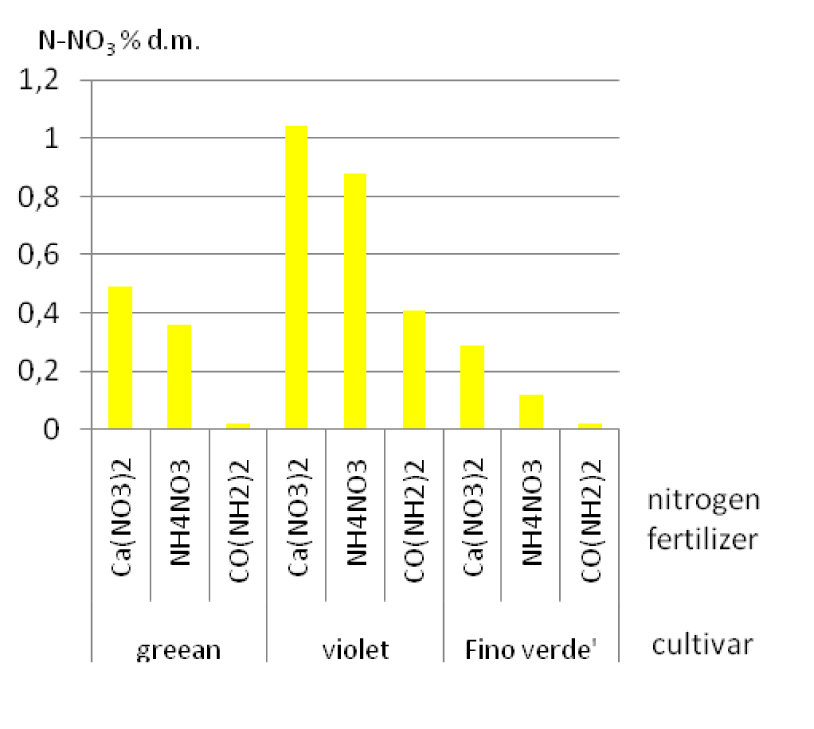Changes in the content of total nitrogen and mineral nitrogen in the basil herb depending on the cultivar and nitrogen nutrition
Abstract
Among fundamental nutrients, nitrogen fertilization is considered one of the most effective factors affecting both the yield and the quality of plant material. Nitrogen form used for fertilizing is also of great importance. The aim of this study was to investigate the impact of nitrogen nutrition (calcium nitrate, ammonium nitrate, and urea) as well as (green, purple, and ‘Fino Verde’) on the chemical composition and yielding of basil (Ocimum basilicum L.). After drying the plant material at a temperature of 60°C and milling, total nitrogen was determined by means of Kjeldahl method, while mineral nitrogen content (N-NH4, N-NO3) was analyzed in 2% acetic acid extract. Yield of fresh basil matter depended significantly on the variety grown. The highest yields were obtained from a cultivar of ‘Fino Verde’ fertilized with ammonium nitrate. The purple variety plants fertilized with urea were characterized by a largest amount of total nitrogen. The ‘Fino Verde’ cultivar fertilized with urea accumulated the least quantities of nitrates in the basil herb.
References
Adler P.R., Simon J.E., Wilcox G.E. 1989. Nitrogen form alters sweet basil growth and essential oil content and composition. Hort. Science 24: 789–790.
Biesiada A., Kucharska A., Sokół-Łętowska A. 2010. Wpływ nawożenia azotem i terminu zbioru na skład chemiczny i aktywność antyoksydacyjną bazylii pospolitej (Ocimum basilicum L.). Proekologiczna uprawa warzyw – problemy i perspektywy (Ogólnopolska Konferencja Naukowa pod patronatem Ministra Rolnictwa i Rozwoju Wsi, Siedlce, 24-25 czerwca 2010 r.): 34–35.
Dzida K. 2010. Nutrients content in sweet basil (Ocimum basilicum L.) herb depending on calcium carbonate dose and cultivar. Acta Sci. Pol., Hortorum Cultus 9 (4): 143–151.
Dzida K. 2011. Influence of nitrogen nutrition and cultivar on quality of sweet basil herbs. Annales UMCS sec. DDD XXIV 3 (14): 125–132.
Golcz A., Politycka B., Seidler-Łożykowska K. 2006. The effect of nitrogen fertilization and stage of plant developmet on the mass and quality of sweet basil leaves (Ocimum basilicum L.). Herba Pol. 52 (1‑2): 22–30.
Golcz A., Seidler-Łożykowska K. 2008. Bazylia pospolita (Ocimum basilicum L.). Wyd. UP, Poznań.
Halva S., Puukla L. 1987. Studies on fertilization of dill (Anethum graveolens L.) and basil (Ocimum basilicum L.) I. Herb yield of dill and basil affected by fertilization. J. Agric. Sci. in Finland 56: 11–17.
Markiewicz B., Golcz A., Kozik E. 2002. Effect of nitrogen fertilization and of harvest term on the yield, content of essential oil and nitrogen in the herb of two cultivars of sweet basil (Ocimum basilicum L.). Rocz. AR Pozn. 341, Ogrod. 35: 19–24.
Nowosielski O. 1988. Zasady opracowywania zaleceń nawozowych w ogrodnictwie PWRiL, Warszawa.
Nurzyńska-Wierdak R. 2001. Analiza zawartości i składu chemicznego olejku dwóch form bazylii wonnej (Ocimum basilicum L.). Annales UMCS sec. EEE, Horticultura 10 (suppl.): 189–193.
Nurzyńska-Wierdak R. 2007a. Evaluation of morphological and developmental variability and essential oil composition of selected basil cultivars. Herba Pol. 53 (3): 255–261.
Nurzyńska-Wierdak R. 2007b. Comparing the growth and flowering of selected basil (Ocimum basilicum L.) varieties. Acta Agrobot. 60 (2): 127–131.
Nurzyńska-Wierdak R., Borowski B., Dzida K. 2011a. Yield and chemical composition of basil gerb depending on cultivar and foliar feeding with nitrogen. Acta Sci. Pol., Hortorum Cultus 10 (1): 207–219.
Nurzyńska-Wierdak R., Rożek E., Borowski B. 2011b. Response of different basil cultivars to nitrogen and potassium fertilization: total and mineral nitrogen content in herb. Acta Sci. Pol., Hortorum Cultus 10 (4): 217–232.
Nurzyńska-Wierdak R. 2012. Ocimum basilicum L. – wartościowa roślina przyprawowa, lecznicza i olejkodajna. Praca przeglądowa. Annales UMCS sec. EEE, Horticultura 22: 20–30.
Nurzyński J. 2008. Nawożenie roślin ogrodniczych. Wyd. AR, Lublin.
Omer E.A., Elsayed Abdel-Ghafor A., El‑Lathy A., Khattab M.E., Sabra A.S. 2008. Effect of the nitrogen fertilizer forms and time of their application on the yield of herb and essential oil of Ocimum americanum L. Herba Pol. 54 (1): 34–46.
Sifola M.I., Barbieri G. 2006. Growth, yield and essential oil content of three cultivars of basil grown under different levels of nitrogen in the field. Sci. Hort. 108: 408–413.
Švecová E., Neugebauerová J. 2010. A study of 34 cultivars of basil (Ocimum L.) and their morphological, economic and biochemical characteristics, using standardized descriptors. Acta Univ. Sapientiae, Alimentaria 3: 118–135.
Tesi R., Chisci G., Nencini A., Tallarico R. 1995. Growth response to fertilization on sweet basil (Ocimum basilicum L.). Acta Hort. 390: 93–96.


This work is licensed under a Creative Commons Attribution-NonCommercial-NoDerivatives 4.0 International License.
The journal is licensed by Creative Commons under BY-NC-ND license. You are welcome and free to share (copy and redistribute the material in any medium or format) all the published materials. You may not use the material for commercial purposes. You must give appropriate credit to all published materials.
The journal allow the author(s) to hold the copyrights and to retain publishing rights without any restrictions. This is also indicated at the bottom of each article.





